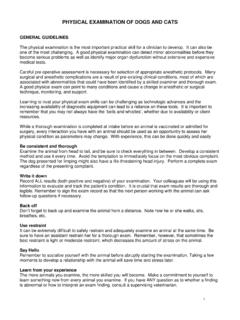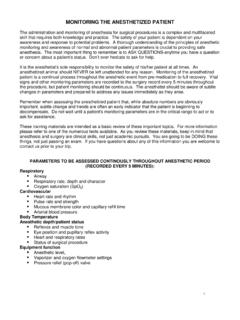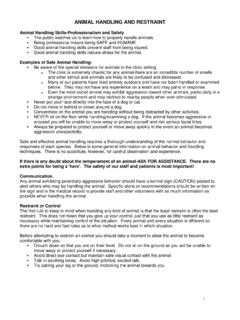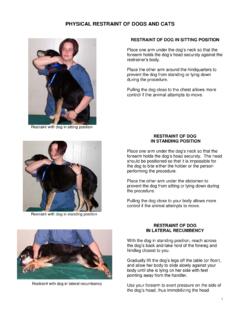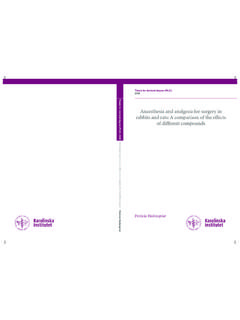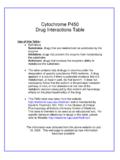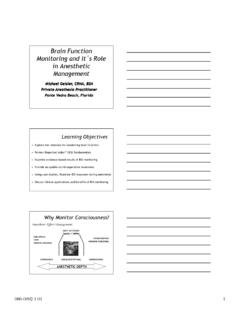Transcription of ANESTHETIC AGENTS - RURAL AREA VET
1 1 ANESTHETIC AGENTS The following provides a very brief overview of the ANESTHETIC AGENTS most commonly used in HSVMA-RAVS small animal protocols. This is NOT a detailed monograph on the listed drugs. Consult additional anesthesia texts or Plumb s Veterinary Drug Handbook for more detailed information. PRE-ANESTHETICS AND ANALGESICS ANTICHOLINERGICS Atropine Mode of Action Blocks the action of acetylcholine at the terminal ends of the parasympathetic nervous system, thereby reversing parasympathetic effects. Effects Increased heart rate Reduced GI activity Decreased tear and salivary secretions Use Preferred agent to counteract vagally-induced bradycardia. Can be given IV, IM or SQ. Duration of effect: 45-90 minutes Precautions Cardiac: Avoid w/ tachycardia (HR > 140 in K9, 180 in feline) or clinical signs of heart failure; may induce cardiac arrhythmias.
2 Partial dosing can result in paradoxical bradycardia GI: Constipation or obstruction Can result production of thick mucous in the airways, particularly in cats. Glycopyrrolate Synthetic derivative of atropine with similar effects. Onset and duration of effect longer than atropine - not for use in emergency situations. May be less likely to cause tachycardia and cardiac arrhythmias than atropine Can cause an initial paradoxical bradycardia and AV block when given IV. This effect is usually overcome as plasma levels become therapeutic Note: Hypothermia results in decreased depolarization of cardiac pacemaker cells, causing bradycardia. Since not vagally mediated, this bradycardia can be refractory to anticholinergics.
3 OPIOIDS The opioids are a diverse group of naturally occurring and synthetic drugs used primarily for their analgesic activity. Opioids combine reversibly with specific receptors in the central nervous system, altering the transmission and perception of pain. The clinical effects of opioids vary between the mu opioid receptor agonists (morphine, hydromorphone), partial mu agonists (buprenorphine), and agonist-antagonists (butorphanol), and depend on additional patient factors, including the presence or absence of pain, physical condition of the animal, concurrent drugs administered, and individual sensitivity. Caution should be used with most opioids in the following cases: Respiratory disease or chest injury; head trauma, increased CSF pressure or other CNS dysfunction; hypothyroidism, severe renal disease or Addison s disease; geriatric or debilitated patients.
4 2 Morphine Sulfate Mode of Action Pure mu agonist Effects Potent analgesia and sedation Minimal cardiovascular effects though higher doses can cause bradycardia Respiratory depression (usually not clinically-relevant) Method of Use Can be administered IV, IM or SQ Duration of effect is 2-6 hours Can also be used for epidural analgesia Reversible with naloxone Schedule II controlled drug Precautions Significant sedative synergism between morphine and acepromazine in the dog reduce acepromazine dose Use with caution in cats if no sedative/tranquilizer is used due to potential excitatory response May cause panting (due to resetting of thermoregulatory mechanism) Often causes vomiting and defecation when given IM or SQ Buprenorphine (Buprenex ) Mode of Action Partial mu agonist More potent than morphine and of longer duration due to its slow dissociation from receptors Effects Moderate analgesia Minimal, if any, sedative effect Method of Use Can be administered IV or IM In cats, is also well absorbed via oral mucosa Delayed onset time to peak effect.
5 20-30 mins IV, 45-60 mins IM Duration of effect influenced by dose (4-8 hrs) Schedule III controlled drug Precautions Difficult to reverse if undesirable effects occur (uncommon) Butorphanol (Torbugesic ) Mode of Action Mixed agonist/antagonist (kappa agonist, mu antagonist) Effects Mild to moderate analgesia, moderate-strong sedative Method of Use Can be administered IV, IM or SQ Duration of effect is 30-60 mins in dogs and 1-3 hrs in cats Reversible with naloxone Schedule IV controlled drug Precautions Short duration of action may require additional re-dosing or additional analgesics post-procedure 3 PHENOTHIAZINES Acepromazine Mode of Action Thought to depress portions of the reticular activating system causing sedation.
6 Anticholinergic, antihistamine, antispasmodic and alpha-adrenergic blocking effects. Effects Strong sedative Antiemetic effect Method of Use Used in healthy adult animals in combination with opioid analgesic as a pre- ANESTHETIC sedative and to help decrease dose of general ANESTHETIC required. May be administered PO, SQ, IM or IV (with caution). Duration of effect is 6-8 hrs Precautions Increased potency in geriatric animals, neonates and animals with liver dysfunction. No analgesic effect-painful patients should be treated with NSAID or opiod instead. Can cause significant hypotension. Maximum total dose is 3 mg, regardless of body weight NSAIDS (Non-Steroidal Anti-Inflammatory Drugs) Ketoprofen Mode of Action Inhibits inflammatory cascade by blocking cyclooxygenase (COX) enzymes.
7 Effects Antipyretic, analgesic and anti-inflammatory effects via inhibition of cyclooxygenase-2 (COX-2) COX-1 inhibition effects platelet function and integrity of gastrointestinal mucosa Method of Use May be administered PO, IM or IV. Duration of effect is 12-18 hrs Precautions Avoid in animals with hepatic or renal disease and in dehydrated or hypotensive patients. Do not combine with other drugs known to alter hemostasis or cause gastrointestinal erosion (aspirin, corticosteroids, etc) Generally avoided for long-term use due to substantial risk of GI side effects with prolonged use. Notes Other drugs in this class occasionally used include carprofen, etodolac, and meloxicam. ALPHA-2 AGONISTS Dexmedetomidine (DexDomitor ) Mode of Action Alpha-2 adrenoreceptor agonists - Stimulation of these receptors causes a decrease in the level of norepinephrine released in the brain resulting in sedation and analgesia.
8 Effects Profound sedation and anxiolytic action. Moderate to profound analgesia Peripheral vasoconstriction resulting in increased systemic vascular resistance and increased blood pressure. Heart rate decreases to compensate for the increased blood pressure and maintain cardiac output. Lowered respiratory rates and a reduction in body temperature Method of Use May be administered IM or IV. Onset of action following IM injection is 5 minutes and 1 minute following IV dose Duration of sedation is 30-90 minutes. 4 Effects are reversible with atipamezole Typically used at doses MUCH lower than the label recommends. Precautions May have the potential to cause severe cardiovascular and respiratory complications.
9 Standard doses of these drugs are given only to young, healthy patients and careful monitoring is essential. Reversal AGENTS are available and can be used if adverse effects are seen. ALPHA-2 ANTAGONISTS Atipamezole (Antisedan ) Mode of Action Alpha-2 antagonist used as reversal agent for medetomidine, dexmedetomidine or xylazine Method of Use Completely, permanently reverses dexmedetomidine effects May be administered IM or IV For complete reversal, administer same volume atipamezole as dexmedetomidine Can be used at partial dose for partial effect Precautions Will reverse all of the effects of dexmedetomidine, including analgesia, thus administration of another analgesic agent may be appropriate at the time of reversal.
10 Notes Yohimbine is an alpha-2 antagonist that is less selective for alpha-2 receptors ( it also is effective at alpha-1 receptors). It may occasionally be used in HSVMA-RAVS clinics. INDUCTION DISSOCIATIVES (Cyclohexamines) Ketamine Mode of Action Disrupts pathways within the cerebrum and stimulates the reticular activating center. Effects Exaggerated reflex responses and increased muscle tone Significant superficial analgesia, but poor visceral analgesia. Increased heart rate May exhibit apneustic respiration (inspiration followed by prolonged pause and short expiration). Method of Use Primarily used as an induction agent or to perform a short procedure with little pain involved. Concurrent use of a tranquilizing agent, such as diazepam, acepromazine, or xylazine, helps prevent excessive muscle rigidity, improves ease of intubation, and provides smoother recovery.
